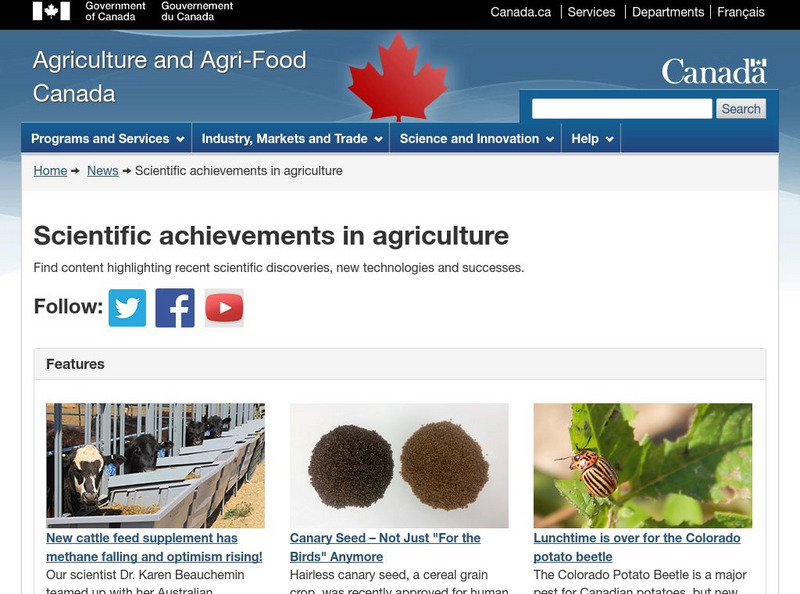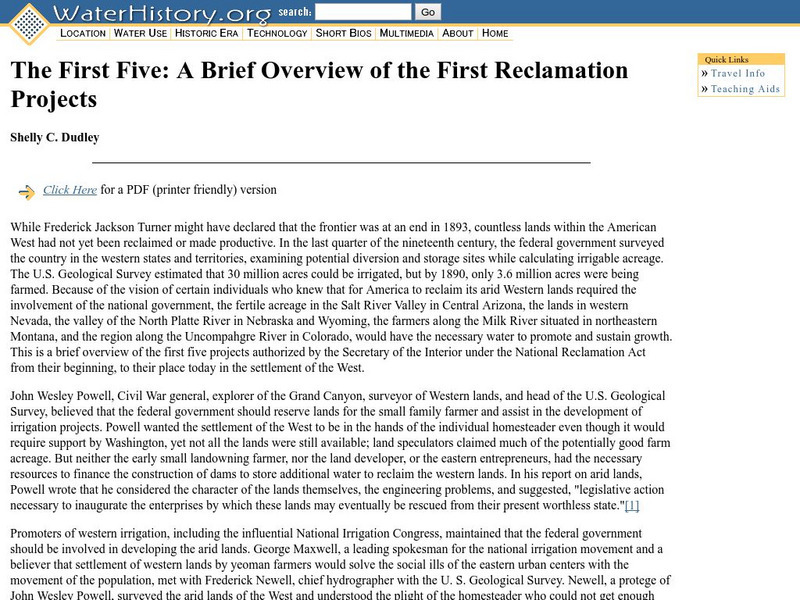Curated OER
Etc: Maps Etc: Agricultural Regions of Asia, 1899
A map of Asia from 1899 showing the primary agricultural production regions of Asia. This map is keyed to show the Northern Plain - region of forests (I), Central Asia - steppes and deserts (II), Mediterranean region - fruits, cereals,...
Curated OER
Educational Technology Clearinghouse: Maps Etc: Products of India (I), 1912
A map from 1912 of India, showing the major agricultural production regions for millets and pulses (grain crops), cotton, coffee, opium and tobacco. The map shows major cities, rivers, and terrain that effect cultivation and...
Council for Economic Education
Econ Ed Link: Bringing the Market to the Farm
This printable instructional activity discusses producers and consumers from an agricultural perspective. It focuses on choices that the consumer has with regard to purchasing agricultural goods (e.g. fruits and vegetables). As an...
Other
Eh.net Encyclopedia: The u.s.economy in the 1920s
A comprehensive look at the economic growth in the U.S. in the 1920s. Provides statistical information on national product, income and prices, population and labor, agriculture, productivity, coal and petroleum, energy and...
Other
National Ffa
The FFA is an organization that enriches the education of production farm students as well as those who wish to advance careers.
US Geological Survey
Usgs: Vermiculite
Information and statistics on the mineral vermiculite are presented by the USGS. Domestic production, sources, and substitutes are discussed in detail.
Center for Educational Technologies
Exploring the Environment: Global Climate Change
This tutorial looks at carbon dioxide in the atmosphere and how changes can impact wheat production in Kansas.
Other
The Family Farmer
The Family Farm explores the diverse agricultural pursuits of farm families, and serves as a window into the small-scale food production process that modern day consumers have become estranged from.
Unite for Literacy
Unite for Literacy: Plants and Food: Fresh From the Farm
Read about some of the products we get from farms. Includes audio narration in English, Spanish, and Turkish with text in English.
US National Archives
Nara: Prologue Magazine: The Surprising George Washington
This lengthy article from the Prologue Magazine discusses the general state of food production in World War II. In particular the article focuses on thw Women's Land Army, women recruited from both farm and city to grow and harvest the...
Other
Adb: How Remote Sensing Technology Improves Efficiency of Irrigation Systems
With the increase of free satellite data combined with scientific algorithms and cloud computing capacity, developing affordable operational monitoring systems for irrigation management in Asia is now feasible. The use of virtual field...
PBS
Pbs Learning Media: Squatter's Rights
Protecting their farms from elephants is a daily fight for African farmers in the Sahel. In this video segment from Africa, learn about the relationship between the African farmers and elephants in the Sahel.
University of Groningen
American History: Essays: Anglo Amer. Colonization in Texas: Food Production
Describes the role Texas played in trading food crops in the mid-1800s.
Other
Agri Food Trade Service: Agriculture, Food and Beverage Industry Tipsheets
Here's a collection of "fact sheets" offering details on Canada's various industries: Brewery, Dairy, Distillery, Fish and Seafood, Egg, Fruit, Grains and Oilseeds, Honey, Poultry, Red Meat, and more.
Countries and Their Cultures
Countries and Their Cultures: Afar
The Afar occupy an area of Djibouti and northeastern Ethiopia, sometimes called the Afar Triangle. There is a long history of hostility between the Afar and the surrounding groups; the Afar are often considered fierce and warlike. The...
Other
Water History: The First Five: Brief Overview of the First Reclamation Projects
Theodore Roosevelt's presidency had a focus on conservation. This site outlines the first five water projects begun in the early 1900s in the western United States that had a great effect on opening up land for agricultural production.
Travel Document Systems
Tds: Swaziland: Economy
Read how Swaziland is attempting to expand its economy beyond agricultural products. Information is from the U.S. State Dept. Background Notes.
Alabama Learning Exchange
Alex: Fifty States Project
Students will follow simple research steps in the school media center and on the Internet to complete a poster on an assigned state by identifying the state's symbols and agricultural products.
University of Groningen
American History: Outlines: Machines and Science Help Farmers
Interresting site from the University of Groningen explaining the incredible impact of machines and technology on developing resources and improving agriculture.
US Department of Agriculture
Economic Research Service: Hawaii
Explore a thorough state fact sheet on Hawaii from the U.S. Department of Agriculture. You will find information on the population, farm characteristics, top commodities and exports. Also available as a download (Adobe Reader required).
Countries and Their Cultures
Countries and Their Cultures: Gusii
The Gusii are divided into seven clan clusters: Kitutu (Getutu), North Mugirango, South Mugirango, Majoge, Wanjare (Nchari), Bassi, and Nyaribari. Gusiiland is located in western Kenya, 50 kilometers east of Lake Victoria. Since...
Countries and Their Cultures
Countries and Their Cultures: Ibibio
The name "Ibibio" identifies the largest subdivision of people living in southeastern Nigeria, in Akwa Ibom State, and it is generally accepted and used for both ethnic and linguistic descriptions. Like their Igbo neighbors, the Ibibio...
Northern Arizona University
Moche Foodways Archaeological Project: Ciudad De Dios
Read about excavations at Ciudad de Dios, a Late Moche farming village. These excavations reveal information on the types of food production and diets of these ancient people.
University of Michigan
Univerisity of Michigan: A Taste of the Ancient World: Farming at Karanis
See pictures of tools used in grain production in ancient Egypt. The artifacts are similar to tools used today.










